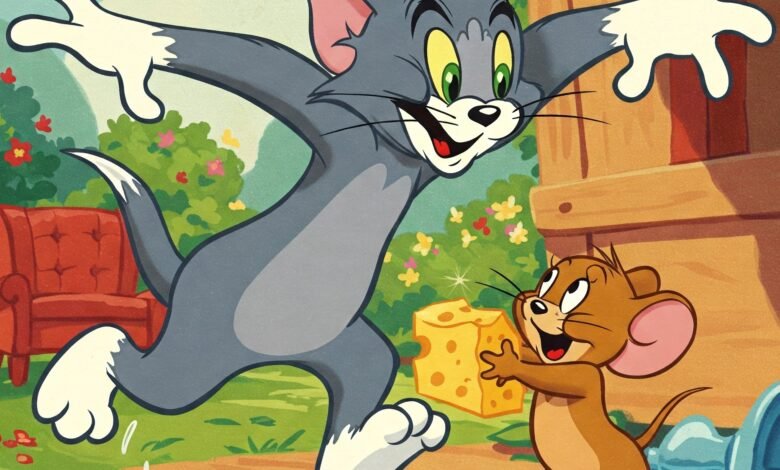The Enduring Legacy of Tom and Jerry: Lessons from the Iconic Cartoon

Introduction to Tom and Jerry
Tom and Jerry, an iconic animated series, was created by William Hanna and Joseph Barbera in 1940. Premiering on February 10, 1940, this timeless cartoon features the comedic rivalry between a clever mouse named Jerry and a hapless cat named Tom. Over the years, Tom and Jerry has evolved into a cultural phenomenon, delighting audiences of all ages with its unique storytelling approach that relies on visual humor and slapstick comedy. The lack of dialogue enhances the comedic situations, captivating viewers through exaggerated actions and expressive character design.
The show’s charm lies in the distinctive personalities of its characters. Tom, the cat, plays the role of the perennial antagonist, continuously devising elaborate schemes to capture Jerry. In contrast, Jerry is the quick-witted mouse who always manages to outsmart Tom, showcasing resourcefulness and cunning. This dynamic creates an engaging narrative that keeps audiences entertained while subtly illustrating themes of perseverance and ingenuity.
Throughout its enduring legacy, Tom and Jerry has not only entertained generations but also won numerous accolades, including several Academy Awards for Animated Short Film. The series has seen various adaptations and spin-offs, demonstrating its adaptability and relevance in the evolving landscape of animation. From its original theatrical shorts to modern adaptations for television, Tom and Jerry successfully bridges the gap between classic and contemporary animation, ensuring its status as a beloved series in the hearts of viewers worldwide.
The series’ impact extends beyond entertainment; it has influenced other animated works and continues to inspire countless animators and storytellers. As the years roll on, the lessons embedded within the antics of Tom and Jerry, such as friendship, rivalry, and resilience, remain as relevant today as they were at their inception, solidifying their place in the pantheon of animation history.
The Characters: Tom and Jerry
At the heart of the iconic cartoon “Tom and Jerry” lies the compelling dynamic between its two main characters: Tom, the mischievous cat, and Jerry, the clever mouse. Their rivalry is a central theme that not only drives the narrative but also serves as a reflection of various human interactions. Tom is often portrayed as a determined and ambitious feline, attempting to catch Jerry, who epitomizes wit and resourcefulness. This contrast creates an engaging interplay that resonates with audiences of all ages.
Tom’s character often embodies the struggle of persistence against cleverness, showcasing a range of emotions from frustration to brief moments of triumph. His relentless pursuit of Jerry demonstrates themes of aspiration and futility, while his failures make him a relatable character. Jerry, on the other hand, is the quintessential underdog, exhibiting bravery and cleverness in the face of adversity. His ability to outsmart Tom not only endears him to viewers but also highlights the idea that intelligence can triumph over brute force.
Furthermore, the development of supporting characters such as Spike, the bulldog, and his son Tyke, adds depth to the storyline. Spike often serves as a guardian figure for Jerry, creating additional layers to the conflict as he inadvertently complicates Tom’s schemes. Their interactions underscore the significance of loyalty and friendship within the comedic chaos, enriching the narrative landscape of the series. Each character, whether protagonist or antagonist, contributes to the timeless charm of “Tom and Jerry,” providing relatable traits that enhance the overall viewing experience.
The Art of Visual Comedy
Tom and Jerry, a timeless cartoon created by William Hanna and Joseph Barbera, showcases a distinctive style of visual comedy that has captivated audiences for decades. At the heart of this humor lies the impeccable timing that defines the series. Each scene is crafted with precision, where comedic moments are built upon carefully orchestrated actions and reactions. This meticulous timing ensures that the punchlines land effectively, often leading to unexpected outcomes that delight viewers. Such attention to timing contributes significantly to the cartoon’s lasting impact.
Another critical aspect of the visual comedy found in Tom and Jerry is the use of exaggerated movement. The characters’ physicality plays a crucial role in amplifying the humor; from the fast-paced chases between Tom and Jerry to the over-the-top expressions of frustration or triumph. This hyperbolic representation of emotions not only accentuates the comedic value but also transcends language barriers, making the cartoon universally appealing. Regardless of cultural background, the exaggerated antics resonate with audiences, offering a shared experience of laughter.
Sound effects further enrich the visual comedy of Tom and Jerry. The clever integration of humorous sound cues complements the actions on screen, enhancing the overall comedic timing. Instances such as the classic “boing” sound during a bounce or the iconic crash noises only serve to elevate the physical gags. These auditory elements are particularly effective in reinforcing the visual comedy, providing a multisensory experience that engages viewers of all ages.
In summary, the art of visual comedy in Tom and Jerry is a testament to the skillful techniques of animation that bring humor to life. With precise timing, exaggerated movements, and strategic use of sound effects, the cartoon continues to captivate audiences across different cultures, leaving behind an enduring legacy of laughter.
Themes and Life Lessons in Tom and Jerry
Throughout the decades, “Tom and Jerry,” created by William Hanna and Joseph Barbera, has captivated audiences with its timeless humor and charm. At its core, the show encapsulates several key themes that resonate deeply with viewers of all ages. One prominent theme is determination. Tom, the ever-ambitious cat, showcases relentless pursuit in his attempts to catch Jerry, the clever mouse. This unwavering commitment to achieving his goal, despite repeated failures, serves as a reminder of the importance of perseverance in the face of adversity. The exaggerated antics highlight that while failures are inevitable, the drive to succeed remains a valuable life lesson.
Cleverness is another central theme showcased in “Tom and Jerry.” Jerry often outsmarts Tom with wit and ingenuity, turning the tables on his feline foe. This ongoing battle represents not just the clash of two characters, but also a broader message about the power of intelligence over brute force. Episodes where Jerry cleverly uses his environment or devises traps emphasize the value of strategizing and thinking outside the box, qualities essential for navigating real-life challenges.
The classic battle of good versus evil is also a recurring theme within the cartoon. While Tom is often perceived as the antagonist, his pursuit of Jerry can sometimes elicit sympathy, blurring the lines between good and evil. Conversely, Jerry’s playful mischief frequently exposes the vulnerabilities of Tom’s character. This dynamic illustrates that morality is not always black and white; rather, it exists on a spectrum where motives and actions create complex narratives.
In essence, the themes of determination, cleverness, and the nuanced portrayal of good versus evil form the foundation of “Tom and Jerry.” These timeless lessons resonate across generations, making the cartoon not only entertaining but also profoundly relatable for audiences, encouraging reflection on resilience, intellect, and ethical ambiguity.
Cultural Impact and Reception
Since its debut in 1940, the animated series “Tom and Jerry” has left a significant mark on global popular culture. The iconic cat-and-mouse duo, created by William Hanna and Joseph Barbera, has not only entertained audiences but has also influenced various forms of media. The show’s distinctive slapstick comedy and minimal dialogue have allowed it to transcend language barriers, making it accessible to viewers around the world. As a result, “Tom and Jerry” has inspired numerous adaptations and variations across different cultures, cementing its status as a timeless classic in animation.
The impact of “Tom and Jerry” extends beyond television. The franchise has spawned a vast array of merchandising opportunities, including toys, clothing, and home entertainment. This has contributed to a multi-billion dollar industry, showcasing how beloved characters can promote revenue in various forms. The characters’ enduring popularity has led to the development of feature films, comic books, and even video games, reflecting the franchise’s versatility and ongoing relevance in contemporary culture.
Throughout its lengthy run, “Tom and Jerry” has received numerous accolades, including several Academy Awards for Animated Short Film. These distinctions highlight the creative excellence and skill displayed in its animation. However, the series has not been without controversy. Some critics argue that the show’s depictions of violence and racial stereotypes warrant scrutiny, prompting discussions about its appropriateness for modern audiences. This nuanced reception serves to frame “Tom and Jerry” as not only an entertainment piece but also a cultural artifact that mirrors societal perspectives of its time.
Ultimately, the multifaceted legacy of “Tom and Jerry” exemplifies its significant cultural impact. Through its various adaptations, accolades, and the discussions it has prompted, the series continues to resonate with viewers, reaffirming its position as an iconic element of animation history.
Tom and Jerry’s Relevance Today
The enduring appeal of the animated series “Tom and Jerry” lies in its ability to resonate with contemporary audiences despite its origins dating back to the 1940s. One of the key factors contributing to its relevance is the consistent airing of the show on television networks around the world. Major broadcast and cable channels continue to feature episodes, catering to both nostalgic viewers and new generations of children. This accessibility ensures that the series remains part of popular culture, enabling it to forge a lasting connection with viewers.
Furthermore, the recent surge in streaming platform subscriptions has facilitated a resurgence of interest in classic cartoons, including “Tom and Jerry.” Services such as HBO Max, Netflix, and others have made the series readily available, allowing audiences to watch it on demand. This on-demand access fosters a familiarity with the characters and their antics, making “Tom and Jerry” an integral part of childhood for many, regardless of when they were born.
Additionally, the creation of new episodes and adaptations serves to revitalize the franchise. Recent projects, including feature films that reimagine the timeless cat-and-mouse chase, capture the interest of current viewers while introducing the characters to those unfamiliar with the original series. These adaptations may incorporate modern storytelling techniques and values, making the themes both relatable and engaging for present-day audiences.
Moreover, the universal humorous escapades of Tom and Jerry transcend cultural barriers, allowing them to remain relevant across diverse demographics. Characters engage in comedic conflicts that, while often exaggerated, mirror everyday struggles and rivalries that people face. This relatability, paired with high-quality animation and creativity, ensures that “Tom and Jerry” retains a place in the hearts of audiences today.
The Psychology Behind the Humor
The enduring appeal of slapstick comedy, epitomized by the antics of Tom and Jerry, can be largely attributed to its deep roots in human psychology. Humor plays a vital role in our emotional landscape, serving as a coping mechanism in times of stress and adversity. Laughter has been shown to activate the brain’s reward centers, releasing endorphins which foster feelings of happiness and relaxation. This biological response underscores why comedic portrayals, such as the exaggerated misadventures between a cat and a mouse, resonate with audiences of all ages.
Slapstick comedy often hinges on physicality and visual gags, providing an immediate sense of gratification. Tom’s attempts to outsmart Jerry often lead to catastrophic failures, creating a unique blend of tension and release that elicits laughter. According to psychologists, this juxtaposition of expectation and reality is pivotal. The anticipation of Tom’s success, followed by the humorous downfall, reflects a relatable human experience—our innate tendency to strive for achievement while often confronting obstacles. This universal theme fosters a connection with viewers, who find humor in the shared struggle of facing unforeseen challenges in their own lives.
Moreover, the cartoon’s character dynamics reveal essential truths about conflict and resilience. While Tom incessantly pursues Jerry, it is the clever mouse who ultimately overcomes through wit and cunning. This reversal of roles invites audiences to laugh at the absurdity of failure while simultaneously appreciating the cleverness of the underdog. Such portrayals can also serve as a metaphor for life’s unpredictability, reminding viewers that setbacks are a natural part of the human experience. Collectively, these comedic elements contribute to the cartoon’s lasting legacy, demonstrating how humor can nurture emotional well-being and foster resilience through shared moments of joy and laughter.
Fan Culture and Community
The animated series Tom and Jerry has cultivated a robust and passionate fan culture that extends across various platforms and formats. Fan art, for instance, serves as a creative expression of admiration for the series, allowing artists to reinterpret the iconic characters and scenarios in unique and imaginative ways. These art pieces not only highlight the individual artist’s style but also engage with the broader Tom and Jerry community, inviting discussions about personal interpretations and nostalgic recollections associated with the show.
Furthermore, conventions dedicated to animation and classic television often feature panels, merchandise, and activities centered around Tom and Jerry, drawing in fans who share a common appreciation for the series. Such events provide an opportunity for fans to connect face-to-face, exchange stories about their favorite episodes, and foster friendships that span geographical boundaries. The camaraderie among fans often transcends the simple enjoyment of the show, creating a shared cultural tapestry rich with humor and nostalgia.
The rise of social media has significantly amplified fan engagement, allowing discussions and sharing to take place at an unprecedented scale. Platforms like Twitter, Instagram, and Facebook host groups and pages dedicated to Tom and Jerry where fans can post artwork, memes, and clips, sparking lively conversations. This digital environment has transformed how fans interact, enabling them to share their interpretations of the characters and stories in real time. The accessibility of fan content fosters a spirit of collaboration and innovation, as users remix and reimagine the iconic antics of Tom and Jerry for contemporary audiences.
Ultimately, the enduring legacy of Tom and Jerry thrives not only in its timeless humor but also in the vibrant community that continues to celebrate and reinterpret the series, thus ensuring its relevance for generations to come.
Conclusion: The Legacy of Tom and Jerry
The legacy of Tom and Jerry, an iconic cartoon that has captured the hearts of audiences for generations, cannot be overstated. This animated series, created by William Hanna and Joseph Barbera, has entertained millions since its debut in 1940. At its core, the enduring appeal of the show lies in its timeless themes of rivalry, resilience, and the innocent foolishness of its characters. Tom, the cat, and Jerry, the mouse, offer a comedic perspective on the classic chase dynamic, making it relatable to viewers of all ages.
Through its clever animation and slapstick humor, Tom and Jerry not only showcased extraordinary creativity but also imparted valuable lessons about persistence and ingenuity. The cat-and-mouse antics teach audiences the importance of adaptability and quick thinking. Each episode serves as a demonstration of how determination can lead to unexpected outcomes, often filled with laughter. Importantly, this legacy extends beyond mere entertainment; it has inspired numerous other animated series and influenced storytelling in animation worldwide.
As we reflect on the cultural impact of Tom and Jerry, it is evident that their relevance persists even in contemporary media. The characters have been embraced by newer generations, as evidenced by their adaptations into various formats, including films, merchandise, and digital media. This adaptability ensures that the beloved antics of Tom and Jerry will remain a staple in popular culture. As we look to the future, it is clear that this iconic duo will continue to inspire and entertain, reminding us that the charm of classic animation will never fade. Their legacy will endure, shaping the next wave of animation with their timeless tales of rivalry and adventure.






















